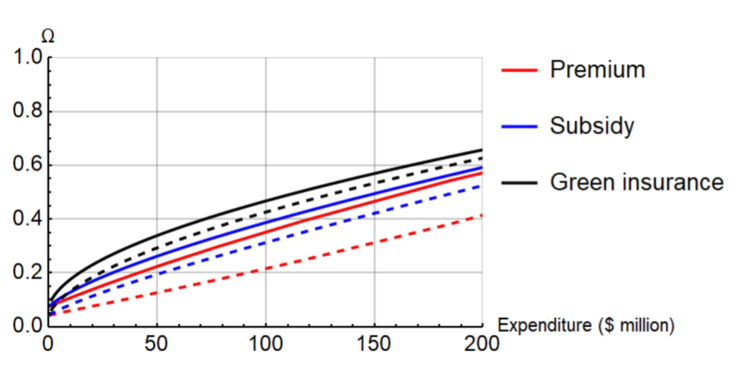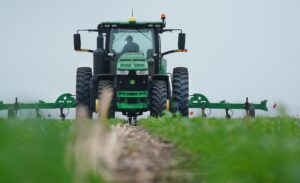Comparing the Effectiveness of Conservation Incentives
May 15, 2024
PAER-2024-17
Megan N. Hughes, Graduate Research Assistant; Meilin Ma, Assistant Professor of Agricultural Economics; and Carson Reeling, Interim Graduate Program Chair of Agricultural Economics
Introduction
Firms in the agricultural supply chain are facing increasing pressure from consumers and policymakers to provide sustainably produced foods (Grunert, 2011; Cecchini et al., 2018). Sustainability in food production is typically achieved through the use of conservation practices, like cover cropping, by farmers. In our study, we focus on cover crops, which are an important conservation practice for attaining various sustainability goals relating to water quality, soil health, and carbon sequestration (Indiana State Department of Agriculture (ISDA), 2018).
In the US, cover cropping and other conservation practices are incentivized by state- or federal-level programs, which share the cost of adoption through subsidies (e.g., the Environmental Quality Incentives Program [EQIP]). Despite the incentives, recent progress on adoption has been slow. For example, in Indiana, the adoption of cover crops has stayed roughly constant at less than 10% of crop acreage since 2015 (Harmon, 2020). As of 2017, only 3.9% of United States crop acreage was under cover cropping (Park et al., 2022). Several barriers to adoption have been identified, including the cost of implementation, farmers’ aversion to risk, and potential impacts on crop yields (Prokopy et al., 2019).
The impacts of conservation practice adoption on a farmer’s profits are complex. Numerous studies investigate the impacts of various cover crop species on both the average crop yield and the variance or volatility of the yield. Some cover crop species have been found to potentially result in a reduction in mean yields and an increase in yield variance over time (Plastina et al., 2023). Our study focuses on cereal rye, which, according to previous studies, may reduce mean yields initially through a variety of mechanisms, such as nitrogen scavenging from the soil (Lacey & Armstrong, 2015; Ruffatti et al., 2019) and the delayed release of nitrogen from a previous cover crop (Lacey et al., 2020; Roth et al., 2023).
When making the decision to adopt a conservation practice, risk-averse farmers consider how adoption affects the entire distribution of their profits over a span of time (e.g., Liu, 2013; Oliva et al., 2020). The current incentive programs will only affect mean farm profits without influencing their variance. Our study (Ma et al., 2023) compares the effectiveness of three conservation practice incentives: (i) price premiums paid for crops produced with cover crops; (ii) cost-share subsidies; and (iii) “green insurance,” which compensates farmers in the event of loss due to conservation practice adoption.
Methodology and Data
We built a dynamic model of farmers’ adoption decisions under each conservation instrument, given the impacts of cover cropping on the mean and variance of yield. The model considers variations in farmers’ risk preferences and land tenure status (i.e., land renters versus landowners).
To calibrate our model, we employ a unique dataset compiled by researchers from Purdue’s Department of Agronomy. The dataset contains 430 pairs of observations from 28 experiment sites located in six states across the Midwest over the period 2001-2018. Corn is grown on each plot, and the paired plots are identical in location, soil type, slope, weather condition, and nutrient application. Each pair differs only in that a cereal rye cover crop was grown on the treatment plot, while the control plot did not have a cover crop. We use standard statistical procedures to estimate the effect of cover crop adoption on the mean and variance of yield over time.
Identifying the varying impacts of cover crops on yields over time allows us to study the effect of differences in farmers’ decision horizons on adoption incentives. This is important as decision horizons may be tied to ownership status; if a farmer is renting land, they may have shorter decision horizons and, hence, will make different decisions regarding the management of that land compared to an owner. This is because renters may not consider the long-term impacts of cover crop adoption, given the uncertainties inherent in renting.
Results
After controlling for variables that can affect yield, like precipitation and soil quality, we find that a cereal rye cover crop tends to generate yield losses over the first 3 years of adoption. In the medium term (3-7 years), there is a small yield gain on average and a small reduction in yield volatility. In the longer term, the reduction in yield volatility grows. We use our model to simulate the share of Indiana farmland owners and renters who would adopt a cover crop under each instrument.
Figure 1 shows that adoption is greatest under green insurance at all levels of expenditure, followed by the subsidy and then the premium. This implies that green insurance is the most cost-effective instrument that we examine. Green insurance is the only instrument that both increases the mean returns to adopting farmers and decreases the variance. It is intuitive that this mechanism would be preferred by risk-averse farmers over the other mechanisms, which either increase or have no effect on variance. For all instruments, adoption is lower for renters than landowners, reflecting the inability of renters to capture the long-term benefits of cover crops. The difference in adoption rates between owners and renters is smallest under green insurance, whereas adoption among renters is about 4 percentage points lower at all levels of expenditure.

Figure 1: Share of owners (solid lines) and renters (dashed lines) adopting under each instrument for a given expenditure on each instrument
Conclusion
Promoting conservation practices is a major way of enhancing the sustainability of agricultural production. Adopting conservation practices can have a long-run effect on the distribution of crop yields. We show that the way in which adoption incentives interact with these yield effects can influence the success of instruments in terms of cost-effectiveness and the characteristics of adopting farmers. Our results have important policy implications because a large share of US farmland is operated by renting farmers. We show that land tenure status impacts conservation practice adoption, which should be considered by policymakers seeking to optimize conservation programs.
References
Cecchini, L., Torquati, B., and Chiorri, M. (2018). “Sustainable agri-food products: A review of consumer preference studies through experimental economics.” Agricultural Economics 64(12), 554-565. https://doi.org/10.17221/272/2017-agricecon
Grunert, K.G. (2011). Sustainability in the food sector: A consumer behaviour perspective. International Journal on Food System Dynamics 2(3), 207-18. https://doi.org/10.18461/ijfsd.v2i3.232
Harmon, L. (2020). Indiana Cover Crops: 2011–2019. Indiana State Department of Agriculture. Available: https://www.in.gov/isda/files/Cover-Crop-Trends-2011-2019-Statewide.pdf
Indiana State Department of Agriculture (ISDA). (2018). Indiana’s State Nutrient Reduction Strategy. https://www.in.gov/isda/divisions/soil-conservation/indiana-state-nutrient-reduction-strategy/
Lacey, C., & Armstrong, S. (2015). The efficacy of winter cover crops to stabilize soil inorganic nitrogen after fall-applied anhydrous ammonia. Journal of Environmental Quality 44(2), 442–448. https://doi.org/10.2134/jeq2013.12.0529
Lacey, C., Nevins, C., Camberato, J., Kladivko, E., Sadeghpour, A. & Armstrong, S. (2020). Carbon and nitrogen release from cover crop residues and implications for cropping systems management. Journal of Soil and Water Conservation 75(4), 505–514. https://doi.org/10.2489/jswc.2020.00102
Liu, E.M. (2013). Time to change what to sow: Risk preferences and technology adoption decisions of cotton farmers in China. Review of Economics and Statistics 95(4), 1386–1403. https://doi.org/10.1162/rest_a_00295
Ma, M., Reeling, C., Hughes, M.N., Armstrong, S., & Roth, R. (2023). Comparison of conservation instruments under long-run yield uncertainty and farmer risk aversion. European Review of Agricultural Economics 50(5), 1685-1714. https://doi.org/10.1093/erae/jbad029
Oliva, P., Jack, B.K., Bell, S., Mettetal, E., and Severen, C. (2020). Technology adoption under uncertainty: take-up and subsequent investment in Zambia. Review of Economics and Statistics 102(3), 617-632. https://doi.org/10.1162/rest_a_00823
Park, B., Rejesus, R.M., Aglasan, S., Che, Y., Hagen, S.C., and Salas, W. (2022). Payments from agricultural conservation programs and cover crop adoption. Applied Economic Perspectives and Policy 45(2), 1–24. https://doi.org/10.1002/aepp.13248
Plastina, A., Acharya, J., Mauri Marcos, F., Parvej, M.R., Licht, M., & Robertson, A. (2023). Net returns to cereal rye preceding no-till corn in integrated Iowa operations. Iowa State University Extension and Outreach Ag Decision Maker 27(3), 4–5. https://www.card.iastate.edu/products/publications/synopsis/?p=1360
Prokopy, L.S., Floress, K., Arbuckle, J.G., Church, S.P., Eanes, F.R., Gao, Y., Gramig, B.M., Ranjan, P., & Singh, A.S. (2019). Adoption of agricultural conservation practices in the United States: Evidence from 35 years of quantitative literature. Journal of Soil and Water Conservation 74(5), 520–534. https://doi.org/10.2489/jswc.74.5.520
Roth, R.T., Lacey, C.G., Camberato, J.J., & Armstrong, S.D. (2023). Quantifying the fate of nitrogen from cereal rye root and shoot biomass using 15N. Nutrient Cycling in Agroecosystems 125(2), 219–234. https://doi.org/10.1007/s10705-022-10213-5
Ruffatti, M.D., Roth, R.T., Lacey, C.G., & Armstrong, S.D. (2019). Impacts of nitrogen application timing and cover crop inclusion on subsurface drainage water quality. Agricultural Water Management 211, 81–88. https://doi.org/10.1016/j.agwat.2018.09.016
